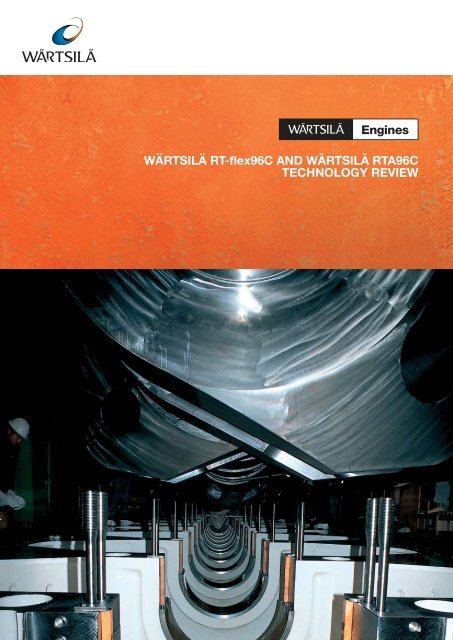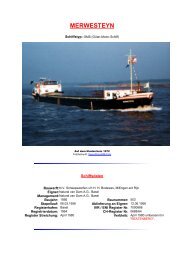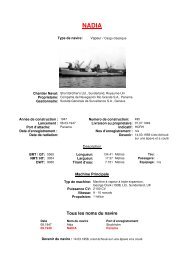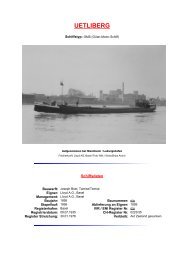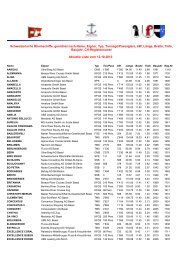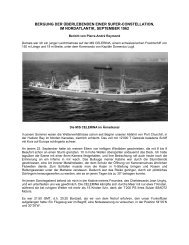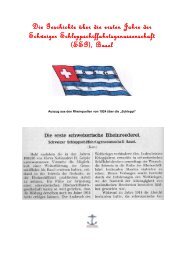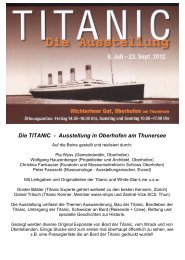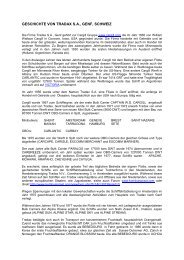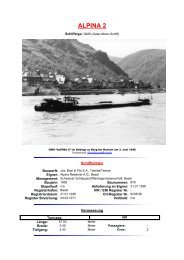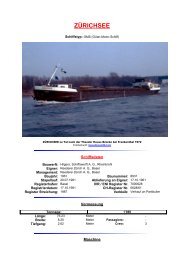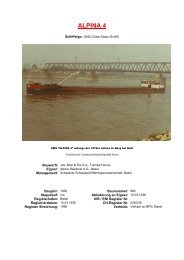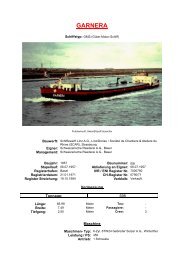WÄRTSILÄ RT‑flex96C AND WÄRTSILÄ RTA96C ... - Swiss-Ships
WÄRTSILÄ RT‑flex96C AND WÄRTSILÄ RTA96C ... - Swiss-Ships
WÄRTSILÄ RT‑flex96C AND WÄRTSILÄ RTA96C ... - Swiss-Ships
You also want an ePaper? Increase the reach of your titles
YUMPU automatically turns print PDFs into web optimized ePapers that Google loves.
<strong>WÄRTSILÄ</strong> <strong>RT‑flex96C</strong> <strong>AND</strong> <strong>WÄRTSILÄ</strong> <strong>RTA96C</strong><br />
TECHNOLOGY REVIEW
<strong>WÄRTSILÄ</strong> <strong>RT‑flex96C</strong> <strong>AND</strong><br />
<strong>WÄRTSILÄ</strong> <strong>RTA96C</strong><br />
TECHNOLOGY REVIEW<br />
This is a brief guide to the technical features and benefits of<br />
Wärtsilä <strong>RT‑flex96C</strong> and <strong>RTA96C</strong> low‑speed marine diesel engines.<br />
INTRODUCTION ............................................................ 4<br />
DEVELOPMENT BACKGROUND ..................................... 6<br />
RT‑flex: CONCEPT <strong>AND</strong> BENEFITS ................................. 8<br />
RT‑flex COMMON‑RAIL SYSTEM APPLIED ...................... 8<br />
RT‑flex: REAL IN‑SERVICE FUEL ECONOMY .................. 10<br />
RT‑flex: CLEANER IN THE ENVIRONMENT ..................... 10<br />
<strong>RTA96C</strong>:<br />
THE TRADITIONAL CAMSHAFT ARRANGEMENT............ 11<br />
ENGINE STRUCTURE .................................................. 13<br />
RUNNING GEAR ......................................................... 14<br />
COMBUSTION CHAMBER ............................................ 17<br />
PISTON‑RUNNING BEHAVIOUR .................................... 17<br />
TURBOCHARGING <strong>AND</strong> SCAVENGE AIR SYSTEM .......... 18<br />
INSTALLATION ARRANGEMENTS ................................. 19<br />
WASTE HEAT RECOVERY:<br />
FUEL SAVING WITH REDUCED EMISSIONS ................... 20<br />
MAINTENANCE .......................................................... 21<br />
SHIP REFERENCES ..................................................... 22<br />
MAIN TECHNICAL DATA .............................................. 23<br />
3
12‑cylinder Wärtsilä <strong>RT‑flex96C</strong> engine giving 68,640 kW (93,360 bhp).<br />
INTRODUCTION<br />
The Wärtsilä <strong>RT‑flex96C</strong> and <strong>RTA96C</strong> low‑<br />
speed marine diesel engines, with a power<br />
range of 25,320 to 84,420 kW, are tailor‑<br />
made for the economic, reliable propulsion of<br />
large, fast container liners. They offer clear,<br />
substantial benefits:<br />
• High power outputs at optimum shaft<br />
speeds<br />
• Reliability and proven design<br />
• Competitive first cost<br />
• Economical fuel consumption over the<br />
whole operating range<br />
• Low cylinder oil feed rate<br />
• Three years between overhauls<br />
• Low maintenance costs<br />
4<br />
• Full compliance with the NOX<br />
emission<br />
regulation of Annexe VI of the MARPOL<br />
1973/78 convention.<br />
The Wärtsilä <strong>RT‑flex96C</strong> has additional<br />
benefits:<br />
• Smokeless operation at all running speeds<br />
• Better fuel economy in the part‑load range<br />
• Lower steady running speeds<br />
• Reduced maintenance requirements with<br />
simpler engine setting and extendable time<br />
between overhauls.<br />
The Wärtsilä <strong>RTA96C</strong> two‑stroke diesel engine<br />
was introduced in December 1994 to meet<br />
the demand for even higher power outputs to<br />
propel the then coming generation of larger<br />
and faster container ships. It followed in a<br />
long line of RTA‑series engines with each<br />
generation bringing higher power outputs to<br />
cater for ever increasing ship sizes.<br />
The <strong>RTA96C</strong> was readily accepted in the<br />
market. Its reliability was acknowledged very<br />
quickly by the containership operators and led<br />
to a very good reputation, further applications<br />
and repeat orders.<br />
The Wärtsilä <strong>RT‑flex96C</strong> two‑stroke diesel<br />
engine was introduced in 2003 by combining<br />
the latest common‑rail technology for fuel<br />
injection and valve actuation with fully‑
integrated electronic control and the well‑<br />
established <strong>RTA96C</strong> engine.<br />
The 14‑cylinder <strong>RT‑flex96C</strong> engines extend<br />
the power spectrum of the RTA series up to<br />
84,420 kW (114,800 bhp). Thus with waste<br />
heat recovery systems which can add up<br />
to 12 per cent of engine power, <strong>RT‑flex96C</strong><br />
engines can meet the propulsion requirements<br />
of large, fast containerships from up to around<br />
12,000 TEU capacity at service speeds of<br />
around 25 knots.<br />
Output bhp<br />
100 000<br />
80 000<br />
60 000<br />
40 000<br />
20 000<br />
10 000<br />
8 000<br />
6 000<br />
RT-flex82T<br />
RTA82T<br />
RT-flex84T-D<br />
RTA84T-D<br />
RT-flex82C<br />
RTA82C<br />
RT-flex68-D<br />
RTA68-D<br />
RT-flex58T-D<br />
RTA58T-D<br />
Principal parameters of Wärtsilä <strong>RT‑flex96C</strong> and <strong>RTA96C</strong> engines<br />
Bore mm 960<br />
Stroke mm 2500<br />
Output MCR, R1 kW/cyl 6030<br />
bhp/cyl 8200<br />
Speed range, R1‑R3 rpm 102–92<br />
BMEP at R1 bar 19.6<br />
Pmax bar 153<br />
Mean piston speed at R1 m/s 8.5<br />
Number of cylinders 6–14*<br />
BSFC: at full load, R1 g/kWh 171<br />
* 13‑ and 14‑cylinder engines only in RT‑flex version.<br />
RTA48T-D<br />
RT-flex96C<br />
<strong>RTA96C</strong><br />
RTA72U-B<br />
60 70 80 90 100 120 140<br />
Engine speed<br />
g/bhph 126<br />
RT-flex60C-B<br />
RTA62U-B<br />
RT-flex50-D<br />
RTA50-D<br />
RTA52U<br />
Output kW<br />
80 000<br />
60 000<br />
50 000<br />
40 000<br />
30 000<br />
20 000<br />
10 000<br />
8 000<br />
6 000<br />
4 000<br />
rev/min<br />
5
DEVELOPMENT BACKGROUND<br />
Wärtsilä has a policy of continuously updating<br />
its engine programme and engine designs to<br />
adapt them to the latest market requirements<br />
and to deliver the benefits of technical<br />
improvements. The Wärtsilä <strong>RT‑flex96C</strong> and<br />
<strong>RTA96C</strong> engine types are good examples of<br />
this policy.<br />
When the design of the <strong>RTA96C</strong> was<br />
introduced in 1994, it was based fully on the<br />
well‑established RTA84C to take advantage of<br />
the wealth of experience in theoretical design,<br />
testbed research and operating service from<br />
the RTA84C and other previous RTA‑series<br />
engines. The first <strong>RTA96C</strong> engines entered<br />
service in 1997.<br />
In 2000, the cylinder power of the <strong>RTA96C</strong><br />
was raised by some four per cent by utilising<br />
potential already in the design. A 14‑cylinder<br />
model was also added to bring the maximum<br />
power up to 80,080 kW (108,920 bhp). The<br />
increased power output was made possible by<br />
6<br />
the very satisfactory service experience with<br />
the engines in service.<br />
Further improvements were subsequently<br />
achieved by the introduction of various design<br />
measures to improve piston‑running behaviour.<br />
These improvements reduce wear rates of<br />
cylinder liners and piston rings, extend times<br />
between overhauls and allow reduced cylinder<br />
oil feed rates.<br />
A major step forward was achieved when<br />
the <strong>RTA96C</strong> was combined with the RT‑flex<br />
electronically‑controlled common‑rail technology<br />
for fuel injection and valve actuation to create<br />
the <strong>RT‑flex96C</strong> engine introduced in 2003. At<br />
the same time, the decision was taken that the<br />
13‑ and 14‑cylinder engines would only be built<br />
in RT‑flex form.<br />
The RT‑flex common‑rail technology had<br />
been introduced first in the RT‑flex58T‑B<br />
engine. Service results with this engine, which<br />
entered service in September 2001, were<br />
excellent, clearly demonstrating that the new<br />
RT‑flex system offers distinctive operational<br />
benefits which are not possible with camshaft<br />
engines. Thus the experience from the<br />
RT‑flex58T‑B engine type, the RT‑flex60C<br />
engine first built in 2002, and the full‑sized<br />
RT‑flex58T research engine since June 1998<br />
were employed in the development of the<br />
<strong>RT‑flex96C</strong> engine.<br />
The first <strong>RT‑flex96C</strong> engines were shop<br />
tested in April 2004 (eight‑cylinder engine)<br />
and June 2004 (12‑cylinder engine). These<br />
subsequently entered service in November and<br />
December 2004 respectively.<br />
The power outputs of <strong>RT‑flex96C</strong> and<br />
<strong>RTA96C</strong> engines were further raised at<br />
the end of 2007 by 5.4 per cent. Thus the<br />
MCR outputs were increased from 5720 to<br />
6030 kW/cylinder, bringing the output of the<br />
14‑cylinder engines to 84,420 kW.
Wärtsilä <strong>RT‑flex96C</strong>.<br />
7
RT‑flex: CONCEPT <strong>AND</strong> BENEFITS<br />
The Wärtsilä RT‑flex system is the result of a<br />
long project since the 1980s to develop low‑<br />
speed marine engines without the constraints<br />
imposed by mechanical drive of fuel injection<br />
pumps and valve actuation pumps but with<br />
far greater flexibility in engine setting to reach<br />
future requirements. The objective is to deliver<br />
operational benefits to the shipowners.<br />
The Wärtsilä <strong>RT‑flex96C</strong> is basically a<br />
standard Wärtsilä low‑speed two‑stroke marine<br />
diesel engine, except that, instead of the usual<br />
camshaft and its gear drive, fuel injection pumps,<br />
exhaust valve actuator pumps and reversing<br />
servomotors, it is equipped with a common‑rail<br />
system for fuel injection, exhaust valve actuation<br />
and air starting, and full electronic control of these<br />
engine functions.<br />
The common‑rail injection system operates<br />
with just the same grades of heavy fuel oil as<br />
are already standard for Wärtsilä low‑speed<br />
engines.<br />
The RT‑flex engines offer a number of<br />
interesting benefits to shipowners and operators:<br />
• Smokeless operation at all operating speeds<br />
• Lower steady running speeds, in the range<br />
of 10‑15 per cent nominal speed, obtained<br />
smokelessly through sequential shut‑off<br />
•<br />
•<br />
•<br />
•<br />
•<br />
•<br />
of injectors while continuing to run on all<br />
cylinders<br />
Reduced running costs through lower part‑<br />
load fuel consumption and longer times<br />
between overhauls<br />
Reduced maintenance requirements, with<br />
simpler setting of the engine. The ‘as‑<br />
new’ running settings are automatically<br />
maintained<br />
Reduced maintenance costs through precise<br />
volumetric fuel injection control leading to<br />
extendable times between overhauls. The<br />
common‑rail system with its volumetric<br />
control gives excellent balance in engine<br />
power developed between cylinders and<br />
between cycles, with precise injection timing<br />
and equalised thermal loads<br />
Reliability is given by long‑term testing of<br />
common‑rail hardware in component test rigs<br />
Higher availability owing to the integrated<br />
monitoring functions<br />
High availability also given by the built‑in<br />
redundancy, provided by the ample capacity<br />
and duplication in the supply pumps, main<br />
delivery pipes, crank‑angle sensors, electronic<br />
control units and other key elements.<br />
RT‑flex COMMON‑RAIL SYSTEM APPLIED<br />
The common rail for fuel injection is a manifold<br />
running the length of the engine at just below<br />
the cylinder cover level. The common rail and<br />
other related pipe work are neatly arranged<br />
beneath the top engine platform and readily<br />
accessible from above.<br />
The common rail is fed with heated fuel oil<br />
at the usual high pressure (nominally 1000<br />
bar) ready for injection. The supply unit has a<br />
number of high‑pressure pumps running on<br />
multi‑lobe cams.<br />
Fuel is delivered from this common rail<br />
through a separate injection control unit<br />
for each engine cylinder to the standard<br />
fuel injection valves which are hydraulically<br />
operated in the usual way by the high‑pressure<br />
fuel oil. The control units, using quick‑acting<br />
Wärtsilä rail valves, regulate the timing of fuel<br />
injection, control the volume of fuel injected,<br />
and set the shape of the injection pattern.<br />
The three fuel injection valves in each cylinder<br />
8<br />
cover are separately controlled so that,<br />
although they normally act in unison, they can<br />
also be programmed to operate separately as<br />
necessary.<br />
The key features of the Wärtsilä RT‑flex<br />
common‑rail system are:<br />
• Precise volumetric control of fuel injection,<br />
with integrated flow‑out security<br />
• Variable injection rate shaping and free<br />
selection of injection pressure<br />
• Stable pressure levels in common rail and<br />
supply pipes<br />
• Possibility for independent control and<br />
shutting off of individual fuel injection valves<br />
• Ideally suited for heavy fuel oil through clear<br />
separation of the fuel oil from the hydraulic<br />
pilot valves<br />
• Well‑proven standard fuel injection valves<br />
• Proven, high‑efficiency common‑rail fuel<br />
pumps.<br />
The RT‑flex system also encompasses exhaust<br />
Rail unit at the cylinder top level of the <strong>RT‑flex96C</strong><br />
engine with electronic control units on the front of<br />
the rail unit for good access.<br />
valve actuation and starting air control. The<br />
exhaust valves are operated in much the same<br />
way as in existing RTA engines by a hydraulic<br />
pushrod but with the actuating energy now<br />
coming from a servo oil rail at 200 bar pressure.<br />
The servo oil is supplied by high‑pressure<br />
hydraulic pumps incorporated in the supply unit<br />
with the fuel supply pumps. The electronically‑<br />
controlled actuating unit for each cylinder gives<br />
full flexibility in timing for valve opening and<br />
closing.<br />
All functions in the RT‑flex system are<br />
controlled and monitored through the<br />
integrated Wärtsilä WECS‑9520 electronic<br />
control system. This is a modular system with<br />
separate microprocessor control units for each<br />
cylinder, and overall control and supervision<br />
by duplicated microprocessor control units.<br />
The latter provide the usual interface for the<br />
electronic governor and the shipboard remote<br />
control and alarm systems.
Inside the rail unit of an <strong>RT‑flex96C</strong> engine during assembly. The exhaust valve<br />
actuator (A) is mounted on the servo oil rail and the injection control unit (B) is on<br />
the fuel rail. Next to the fuel rail is the smaller control oil rail (C) and the return pipe<br />
for servo and control oil (D).<br />
Volumetric<br />
fuel injection<br />
control unit<br />
Exhaust valve<br />
actuator<br />
Fuel<br />
injectors<br />
1000bar fuel HFO / MDO<br />
200bar servo oil<br />
30bar starting air<br />
Exhaust valve<br />
actuating unit<br />
WECS<br />
control<br />
system<br />
Crank<br />
angle<br />
sensor<br />
Schematic of the Wärtsilä RT‑flex system with electronically‑controlled<br />
common‑rail systems for fuel injection, exhaust valve operation and starting air.<br />
Various RT‑flex equipment on the lower platform of a 12<strong>RT‑flex96C</strong> engine. From left to<br />
right, these include (A) the local engine control panel, (B) the automatic fine filter for servo<br />
and control oil, (C) the two electrically‑driven control oil pumps and (D) the supply unit.<br />
Supply unit for a 12<strong>RT‑flex96C</strong> engine with the fuel pumps in Vee‑form arrangement on<br />
the left and the servo pumps on the right of the central gear drive.<br />
9
RT‑flex:<br />
REAL IN‑SERVICE<br />
FUEL ECONOMY<br />
Whereas Wärtsilä RTA‑series engines<br />
have excellent fuel consumption in<br />
general, the RT‑flex system enables further<br />
improvements to be achieved in the part‑<br />
load range. This is because of the freedom<br />
allowed by the RT‑flex system in selecting<br />
optimum injection pressure, fuel injection<br />
timing and exhaust valve timing at all engine<br />
loads or speeds, while ensuring efficient<br />
combustion at all times, even during dead<br />
slow running.<br />
Similar freedom in exhaust valve<br />
timing allows the RT‑flex system to keep<br />
combustion air excess high by earlier valve<br />
closing as the load/speed is reduced. This is<br />
not only advantageous for fuel consumption<br />
but also limits component temperatures,<br />
which would normally increase at low load.<br />
Lower turbocharger efficiencies at part load<br />
normally result in low excess combustion air<br />
with fixed valve timing.<br />
Another important contribution to fuel<br />
economy of the <strong>RT‑flex96C</strong> engines is the<br />
capability to adapt easily the injection timing<br />
to various fuel properties having a poor<br />
combustion behaviour.<br />
DELTA TUNING:<br />
A FUEL EFFICIENCY ALTERNATIVE<br />
Through their flexibility in engine setting,<br />
RT‑flex engines also have an alternative fuel<br />
consumption curve as standard to give lower<br />
BSFC (brake specific fuel consumption) in<br />
what is for many ships the main operating<br />
range. Through Delta Tuning, the BSFC is<br />
lowered in the mid‑ and low‑load operating<br />
range at less than 90 per cent engine power.<br />
The consequent increase in NO X in that<br />
operating range is compensated by reducing<br />
NO X emissions in the high load range. With<br />
both BSFC curves, the engines comply with<br />
the NO X regulation of the MARPOL 73/78<br />
convention.<br />
10<br />
The new alternative BSFC curve for <strong>RT‑flex96C</strong> engines given by Delta Tuning compared with the<br />
original BSFC curves. All curves shown are for engines complying with the IMO NO X regulation.<br />
Smoke emission measurements for <strong>RT‑flex96C</strong> engines compared with the<br />
<strong>RTA96C</strong> engines, both using marine diesel oil.<br />
RT‑flex:<br />
CLEANER IN THE ENVIRONMENT<br />
Exhaust gas emissions have become an<br />
important aspect of marine diesel engines. All<br />
Wärtsilä RTA and RT‑flex engines comply with<br />
the NO X emissions limit of Annex VI of the<br />
MARPOL 73/78 convention as standard.<br />
RT‑flex engines, however, come<br />
comfortably below this NO X limit by virtue of<br />
their extremely wide flexibility in optimising<br />
the fuel injection and exhaust valve<br />
processes.<br />
The most visible benefit of RT‑flex engines<br />
is, of course, their smokeless operation at all<br />
ship speeds. The superior combustion with<br />
the common‑rail system is largely because<br />
the fuel injection pressure is maintained at<br />
the optimum level irrespective of engine<br />
speed. In addition, at very low speeds,<br />
individual fuel injectors are selectively shut<br />
off and the exhaust valve timing adapted to<br />
help to keep smoke emissions below the<br />
visible limit.<br />
Yet the environmental benefits of<br />
RT‑flex engines need not be restricted by<br />
the current state‑of‑the‑art. As all settings<br />
and adjustments within the combustion<br />
and scavenging processes are made<br />
electronically, future adaptations will<br />
be possible simply through changes in<br />
software, which could be readily retrofitted<br />
to existing RT‑flex engines.<br />
A major reduction in all exhaust<br />
emissions, including CO 2, can be obtained<br />
with <strong>RT‑flex96C</strong> engines by combining the<br />
engine with a high‑efficiency waste heat<br />
recovery plant (see page 20).<br />
As well as investigating the scope of<br />
possibilities of the RT‑flex system, Wärtsilä<br />
is carrying out a long‑term research<br />
programme to develop techniques for<br />
further reducing exhaust emissions,<br />
including NO X, SO X and CO 2, in both RTA<br />
and RT‑flex engines.
12‑cylinder Wärtsilä <strong>RTA96C</strong> engine giving 68,640 kW.<br />
<strong>RTA96C</strong>:<br />
THE TRADITIONAL CAMSHAFT ARRANGEMENT<br />
The Wärtsilä <strong>RTA96C</strong> retains the traditional,<br />
mechanical camshaft arrangement for fuel<br />
injection pumps and valve drives.<br />
The camshaft‑driven fuel injection pumps<br />
are of the well‑proven double‑valve controlled<br />
type that has been traditional in Wärtsilä low‑<br />
speed engines. Injection timing is controlled<br />
by separate suction and spill valves regulated<br />
through eccentrics on hydraulically‑actuated<br />
lay shafts. Consequently, great flexibility in<br />
timing is possible through the variable fuel<br />
injection timing (VIT) system for improved part‑<br />
load fuel consumption, and for the fuel quality<br />
setting (FQS) lever to adjust the injection timing<br />
according to the fuel oil quality.<br />
The valve‑controlled fuel injection pump,<br />
in comparison with a helix type, has a plunger<br />
with a significantly greater sealing length.<br />
The higher volumetric efficiency reduces the<br />
torque in the camshaft. Additionally, injection<br />
from a valve‑controlled pump is far more<br />
stable at very low loads and rotational shaft<br />
speeds down to 15 per cent of the rated<br />
speed are achieved. Valve control also has<br />
benefits of less deterioration of timing over<br />
the years owing to less wear and to freedom<br />
from cavitation.<br />
The camshaft is assembled from a number<br />
of segments, one for each pump housing. The<br />
segments are connected through SKF sleeve<br />
couplings. Each segment has an integral<br />
hydraulic reversing servomotor located within<br />
the pump housing.<br />
The camshaft drive uses the well‑<br />
proven arrangement of gear wheels<br />
housed in a double column located<br />
at the driving end in the centre of the<br />
engine, depending upon number of<br />
cylinders. There are three gear wheels in the<br />
camshaft drive. The main gear wheel on the<br />
crankshaft is in one piece and flange‑mounted.<br />
Fuel injection pump with double control valves.<br />
Pump housing with fuel injection pumps and<br />
exhaust‑valve actuator pumps.<br />
11
Three views of principal elements in the engine structure:<br />
bedplate (top left), column (top right) and cylinder jacket (above).<br />
ENGINE STRUCTURE<br />
Wärtsilä RT‑fl ex96C and <strong>RTA96C</strong> engines have<br />
a well‑proven type of structure, with a ‘gondola’‑<br />
type bedplate surmounted by very rigid, A‑<br />
shaped double‑walled columns and cylinder<br />
blocks, all secured by pre‑tensioned vertical tie<br />
rods. The whole structure is very sturdy with low<br />
stresses and high stiffness. Both bedplate and<br />
columns are welded fabrications which are also<br />
designed for minimum machining.<br />
A high structural rigidity is of major<br />
importance for the today’s two‑stroke engine’s<br />
long stroke. Accordingly the design is based on<br />
extensive stress and deformation calculations<br />
carried out by using a full three‑dimensional<br />
fi nite‑element computer model for different<br />
column designs to verify the optimum frame<br />
confi guration.<br />
The cylinder jacket is assembled from<br />
individual cast‑iron cylinder blocks, bolted<br />
together to form a rigid whole. The supply unit<br />
in RT‑fl ex engines, or the fuel pump blocks<br />
in RTA engines, are carried on supports on<br />
one side of the column and the scavenge<br />
air receiver on the other side of the cylinder<br />
jacket. Access to the piston under‑side is<br />
normally from the supply unit side, but is also<br />
possible from the receiver side of the engine,<br />
to allow for maintenance of the piston rod<br />
gland and also for inspecting piston rings.<br />
The tilting‑pad thrust bearing is integrated<br />
in the bedplate. Owing to the use of gear<br />
wheels for the supply unit drive, the thrust<br />
bearing can be very short and very stiff, and<br />
can be carried in a closed, rigid housing.<br />
Finite‑element model of the engine structure for computer<br />
analysis comprising the ‘gondola’ type bedplate, welded<br />
box‑type columns and individual cast‑iron cylinder blocks.<br />
13
Lowering the crankshaft into the bedplate.<br />
RUNNING GEAR<br />
The running gear comprises the crankshaft,<br />
connecting rods, pistons and piston rods,<br />
together with their associated bearings and<br />
piston rod glands.<br />
The crankshaft is semi‑built comprising<br />
combined crank pin/web elements forged from<br />
a solid ingot and the journal pins then shrunk<br />
into the crank web.<br />
The main bearings have white metal shells.<br />
The main bearing caps are held down by two<br />
pairs of elastic holding down studs.<br />
A better understanding of the main bearing<br />
loads is obtained with today’s finite‑element<br />
analysis and elasto‑hydrodynamic calculation<br />
techniques as they take into account the<br />
structure around the bearing and vibration<br />
of the shaft. The FE model comprises the<br />
complete shaft and its bearings together<br />
with the surrounding structure. Boundary<br />
conditions, including the crankshaft stiffness,<br />
can thus be fed into the bearing calculation.<br />
The crosshead bearing is designed to the<br />
same principles as for all other RTA and RT‑flex<br />
14<br />
engines. It also features a full‑width lower half<br />
bearing. The crosshead bearings have thin‑<br />
walled shells of white metal for a high load‑<br />
bearing capacity. Wärtsilä low‑speed engines<br />
retain the use of a separate elevated‑pressure<br />
lubricating oil supply to the crosshead. It<br />
provides hydrostatic lubrication which lifts<br />
the crosshead pin off the shell during every<br />
revolution to ensure that sufficient oil film<br />
thickness is maintained under the gas load.<br />
This has proved crucial to long‑term bearing<br />
security.<br />
Extensive development work has been<br />
put into the piston rod gland because of<br />
its importance in keeping crankcase oil<br />
consumption down to a reasonable level and<br />
maintaining the quality of the system oil.<br />
Today’s RTA and RT‑flex engines employ an<br />
improved design of piston rod gland with gas‑<br />
tight top scraper rings, and large drain areas<br />
and channels. Hardened piston rods are now<br />
standard to ensure long‑term stability in the<br />
gland behaviour.
Piston, piston rod and gland box. Crosshead pins with guide shoes.<br />
with crankshaft distortion<br />
without crankshaft distortion<br />
Load vector<br />
Load diagrams for main bearing with and without crankshaft distortion taken<br />
into account.<br />
Finite‑element analysis of the crank throw of the <strong>RT‑flex96C</strong><br />
under full dynamic loading.<br />
15
Bore‑cooled pistons from the underside.<br />
Cooling oil spray nozzles at top of piston rod.<br />
16
COMBUSTION CHAMBER<br />
The combustion chamber in today’s diesel<br />
engine has a major influence on the engine’s<br />
reliability. Careful attention is needed for the<br />
layout of the fuel injection spray pattern to<br />
achieve moderate surface temperatures and to<br />
avoid carbon deposits.<br />
At Wärtsilä, optimisation of fuel injection<br />
is carried out first by the use of modern<br />
calculation tools, such as CFD (computerised<br />
fluid dynamics) analysis. The calculated results<br />
are then confirmed on the first test engines.<br />
The modern calculation tools were<br />
invaluable with the <strong>RTA96C</strong> which has a<br />
rather shallow combustion chamber owing to<br />
its comparatively short stroke/bore ratio, and<br />
care was needed with the large quantity of fuel<br />
injected to avoid impingement on component<br />
surfaces.<br />
The well‑proven bore‑cooling principle is<br />
also employed in all the combustion chamber<br />
components to control their temperatures, as<br />
well as thermal strains and mechanical stresses.<br />
The solid forged steel, bore‑cooled cylinder<br />
cover is secured by eight elastic studs. It is<br />
equipped with a single, central exhaust valve<br />
in Nimonic 80A which is housed in a bolted‑<br />
on valve cage. The engines have three fuel<br />
injection valves symmetrically distributed in<br />
the cylinder cover. Anti‑corrosion cladding is<br />
applied to the cylinder covers downstream of<br />
the injection nozzles to protect the cylinder<br />
covers from hot corrosive or erosive attack.<br />
The pistons comprise a forged steel crown<br />
with a short skirt. Combined jet‑shaker oil<br />
cooling of the piston crown provides optimum<br />
cooling performance. It gives very moderate<br />
temperatures on the piston crown with a fairly<br />
even temperature distribution right across the<br />
crown surface. No coatings are necessary.<br />
The cylinder liner is also bore cooled. Its<br />
surface temperatures are optimised for good<br />
piston‑running behaviour.<br />
PISTON‑RUNNING<br />
BEHAVIOUR<br />
Today the time between overhaul (TBO) of<br />
low‑speed marine diesel engines is largely<br />
determined by the piston‑running behaviour<br />
and its effect on the wear of piston rings<br />
and cylinder liners. For this reason, Wärtsilä<br />
<strong>RT‑flex96C</strong> and <strong>RTA96C</strong> engines now<br />
incorporate a package of design measures that<br />
enable the TBO of the cylinder components,<br />
including piston ring renewal, to be extended to<br />
at least three years, while allowing the further<br />
reduction of cylinder lubricating oil feed rate.<br />
The standard design measures applied to<br />
newly‑built <strong>RT‑flex96C</strong> and <strong>RTA96C</strong> engines<br />
for improved piston‑running behaviour now<br />
include:<br />
• Liner of the appropriate material, with<br />
sufficient hard phase<br />
• Careful turning of the liner running surface<br />
and plateau honing of the liner over the full<br />
length of the running surface<br />
• Optimised surface temperatures on the<br />
cylinder liner without any insulation or<br />
insulating tubes<br />
• Chromium‑ceramic coated, pre‑profiled<br />
piston rings in all piston grooves<br />
• Anti‑Polishing Ring (APR) with double‑<br />
acting scraper edges at the top of the<br />
cylinder liner<br />
• Increased thickness of chromium layer in<br />
the piston‑ring grooves<br />
• Two bronze rubbing bands on short piston<br />
skirt<br />
• Load‑dependent accumulator lubricating<br />
system for cylinder lubrication.<br />
A key element good piston‑running is the<br />
surface finish of the cylinder liner. Careful<br />
machining and plateau honing gives the<br />
liner an ideal running surface for the piston<br />
rings, together with an optimum surface<br />
microstructure.<br />
The Anti‑Polishing Ring (APR) prevents<br />
the build up of deposits on the top land of the<br />
piston which can damage the oil film on the<br />
liner and cause bore polishing. The APR has a<br />
smaller clearance with the piston crown, and<br />
two scraper edges for greater cleaning effect.<br />
Fully bore‑cooled combustion chamber. Analysis of fuel distribution and injection trajectories in the<br />
cylinder. Colours indicate concentration with blue/green for the<br />
stoichiometric mixture. No combustion calculated.<br />
17
It is important that the liner wall temperature<br />
is optimised over the piston stroke. The use<br />
of chromium‑ceramic coated piston rings in<br />
all grooves allows lower liner temperatures<br />
which are now achieved without mid‑stroke<br />
insulation.<br />
Whilst trying to avoid corrosive wear<br />
by optimising liner wall temperatures, it is<br />
necessary to take out as much water as<br />
possible from the scavenge air. Thus, the<br />
‘underslung’ scavenge air receiver combined<br />
with highly‑efficient vane‑type water<br />
separators fitted after the air cooler and the<br />
effective water drainage arrangements are<br />
absolutely essential for good piston running.<br />
Timed, load‑dependent cylinder lubrication<br />
is provided by the latest Wärtsilä Pulse<br />
Lubricating System (PLS) which ensures<br />
optimum distribution of cylinder lubricating oil<br />
18<br />
on the running surface of the cylinder liner. In<br />
PLS, the feed rate and timing are electronically<br />
controlled at the lubricator pump. There is<br />
full flexibility in the setting of the lubricator<br />
timing point, and volumetric metering ensures<br />
constant oil dosage patterns across the engine<br />
load range. The dosage in quantity and timing<br />
is precisely regulated even for low feed rates.<br />
The guide feed rate for PLS‑equipped engines<br />
after running‑in is 0.7–0.8 g/kWh.<br />
TURBOCHARGING <strong>AND</strong><br />
SCAVENGE AIR SYSTEM<br />
The <strong>RT‑flex96C</strong> and <strong>RTA96C</strong> engines are<br />
uniflow scavenged with air inlet ports in the<br />
lower part of the cylinder and a single, central<br />
exhaust valve in the cylinder cover. Scavenge<br />
The Anti‑Polishing Ring (APR) for <strong>RTA96C</strong> and <strong>RT‑flex96C</strong> engines has a revised<br />
geometry with two edges to clean the piston top land during both the up and down<br />
strokes of the piston.<br />
Piston of an <strong>RTA96C</strong> engine after testing at 110 per cent load. The piston has chromium<br />
ceramic rings in all grooves and two bronze rubbing bands in the short skirt.<br />
air is delivered by a constant‑pressure<br />
turbocharging system with one or more<br />
high‑efficiency exhaust gas turbochargers<br />
depending on the numbers of cylinders. For<br />
starting and during slow‑running, the scavenge<br />
air delivery is augmented by electrically‑driven<br />
auxiliary blowers.<br />
The scavenge air receiver is of an<br />
underslung design with integral non‑return<br />
flaps, air cooler, water separator and the<br />
auxiliary blowers. The turbochargers are<br />
mounted on the scavenge air receiver which<br />
also carries the fixed foot for the exhaust<br />
manifold.<br />
Immediately after the horizontal air cooler,<br />
the scavenge air is swung round 180 degrees<br />
to the engine cylinders, in the process<br />
passing through the vertically‑arranged water<br />
separator. The highly‑efficient water separator
Location of<br />
water separator<br />
Scavenge air flow from the turbocharger through<br />
the horizontal scavenge air cooler and the vertically‑<br />
mounted water separator, exiting left to the engine<br />
cylinders.<br />
comprises a row of vanes which divert the air<br />
flow and collect the water. There are ample<br />
drainage provisions to remove completely<br />
the condensed water collected at the bottom<br />
of the separator. This arrangement provides<br />
the effective separation of condensed water<br />
from the stream of scavenge air which is<br />
imperative for satisfactory piston‑running<br />
behaviour.<br />
Air cooler<br />
Thrust<br />
Wärtsilä low‑speed engines have specific<br />
design features that help to facilitate<br />
shipboard installation.<br />
The engine layout fields give the ship<br />
designer ample freedom to match the<br />
engine to the optimum propeller for the ship.<br />
The engines have simple seating<br />
arrangements with a modest number of<br />
holding down bolts and side stoppers.<br />
For example, a 12‑cylinder <strong>RT‑flex96C</strong> or<br />
<strong>RTA96C</strong> requires 14 side stoppers. No end<br />
stoppers or thrust brackets are needed as<br />
thrust transmission is provided by fitted<br />
bolts or thrust sleeves which are applied to a<br />
number of the holding‑down bolts. The holes<br />
in the tank top for the thrust sleeves can<br />
be made by drilling or even flame cutting.<br />
After alignment of the bedplate, epoxy resin<br />
chocking material is poured around the<br />
thrust sleeves.<br />
Side stopper<br />
Arrangements for transmitting propeller thrust to the engine seatings for<br />
the <strong>RT‑flex96C</strong> and <strong>RTA96C</strong> engines. The inset shows the thrust sleeve for<br />
the thrust bolts.<br />
INSTALLATION ARRANGEMENTS<br />
All ancillaries, such as pumps and tank<br />
capacities, and their arrangement are optimised<br />
to reduce the installation and operating costs.<br />
The number of pipe connections on the engine<br />
that must be connected by the shipyard are<br />
minimised. The engine’s electrical power<br />
requirement for the ancillary services is also<br />
kept down to a minimum.<br />
A standard all‑electric interface is<br />
employed for engine management systems<br />
‑ known as DENIS (Diesel Engine Interface<br />
Specification) ‑ to meet all needs for control,<br />
monitoring, safety and alarm warning<br />
functions. This matches remote control<br />
systems and ship control systems from a<br />
number of approved suppliers.<br />
The engine is equipped with an integrated<br />
axial detuner at the free end of the crankshaft.<br />
An axial detuner monitoring system developed<br />
by Wärtsilä is standard equipment.<br />
19
Turbogenerator set for the high‑efficiency waste heat recovery plant, with<br />
the exhaust‑gas power turbine on the left, the generator on the right, and<br />
the steam turbine to the right of centre.<br />
Indicative performance of <strong>RT‑flex96C</strong> engines with high‑<br />
efficiency waste heat recovery (WHR) plant*<br />
<strong>RT‑flex96C</strong> engine 10 cylinders 12 cylinders 14 cylinders<br />
Reference plant of engine alone:<br />
Engine power, MCR kW 60,300 72,360 84,420<br />
Fuel consumption, g/kWh<br />
Plant combining engine and WHR:<br />
171 171 171<br />
Engine power, MCR kW 60,300 72,360 84,420<br />
WHR turbogenerator output, kWe 7460 8950 10,440<br />
Overall fuel consumption, g/kWh 156 156 156<br />
* Indicative values based on standard reference conditions and 100 per cent engine power at the R1 rating.<br />
The engines with WHR plant employ Delta Tuning.<br />
Exhaust gas<br />
economiser Ship service steam<br />
M<br />
Power turbine<br />
Main engine<br />
Steam turbine<br />
Schematic of a typical waste heat recovery plant for containerships<br />
in the 7000‑9000 TEU range.<br />
WASTE HEAT RECOVERY: FUEL SAVING WITH REDUCED EMISSIONS<br />
An extended form of high‑efficiency waste<br />
heat recovery plant has been developed for<br />
Wärtsilä <strong>RT‑flex96C</strong> engines, providing an<br />
environmentally‑clean solution to reducing<br />
ships’ fuel consumption. The generated<br />
electrical power can be about 12 per cent of the<br />
engine power, and is employed to assist ship<br />
propulsion or for supplying shipboard services.<br />
The generated power thus contributes<br />
significant savings in both fuel costs and<br />
overall exhaust‑gas emissions, such as<br />
CO 2, NO X, SO X, etc. It is the only technology<br />
commercially available today that reduces both<br />
fuel consumption and exhaust emissions at the<br />
same time.<br />
The waste heat recovery plant follows the<br />
20<br />
well‑established concept of passing the exhaust<br />
gases of the ship’s main engine through an<br />
exhaust‑gas economiser to generate steam for<br />
a turbine‑driven generator. However, the quantity<br />
of energy recovered from the exhaust gases<br />
is maximised by adapting the engine to the<br />
lower air intake temperatures that are available<br />
by drawing intake air from outside the ship<br />
(ambient air) instead of from the ship’s engine<br />
room. The engine turbochargers are matched<br />
for the lower air intake temperatures thereby<br />
increasing the exhaust energy.<br />
At the same time, today’s high‑efficiency<br />
turbochargers have surplus capacity at the<br />
engine’s upper load range when matched for<br />
ambient air intake. Thus about 10% of the<br />
G<br />
G<br />
G<br />
G<br />
Ship service power<br />
Aux. engines<br />
engine’s exhaust gas flow can be branched off<br />
to drive a power turbine which is incorporated<br />
in the turbogenerator package.<br />
The overall result of the new concept is<br />
that the quantity of energy recoverable in an<br />
exhaust‑gas economiser and in the power<br />
turbine is increased without affecting the air flow<br />
through the engine. There is thus no increase in<br />
the thermal loading of the engine and there is<br />
no adverse effect on engine reliability.<br />
Heat is also recovered from the engine’s<br />
scavenge air and jacket cooling water for<br />
feedwater heating. The scavenge air coolers<br />
are designed in such a way that the boiler feed<br />
water can be heated close to the evaporation<br />
temperature.
MAINTENANCE<br />
Primary objectives in the design and<br />
development of Wärtsilä low‑speed engines<br />
are high reliability and long times between<br />
overhauls. Three years between overhauls are<br />
now being achieved by engines to the latest<br />
design standards. At the same time, their high<br />
reliability gives shipowners more freedom to<br />
arrange maintenance work within ships’ sailing<br />
schedules.<br />
Yet, as maintenance work is inevitable,<br />
particular attention is given to ease of<br />
maintenance by including tooling and easy<br />
access, and by providing easy‑to ‑understand<br />
instructions.<br />
All major fastenings throughout the<br />
engine are hydraulically tightened. For the<br />
<strong>RT‑flex96C</strong> and <strong>RTA96C</strong>, the dimensions and<br />
weights of these jacks are kept low by the<br />
use of 1500 bar working pressure. Access to<br />
the crankcase continues to be possible from<br />
both sides of the engine. The handling of<br />
components within the crankcase is facilitated<br />
by ample provision for hanging hoisting<br />
equipment.<br />
The Wärtsilä RT‑flex system is designed<br />
to be user friendly, without requiring ships’<br />
engineers to have any special additional skills.<br />
The system incorporates its own diagnostic<br />
functions, and all the critical elements are<br />
made for straightforward replacement. In fact,<br />
the knowledge for operation and maintenance<br />
of RT‑flex engines can be included in Wärtsilä’s<br />
usual one‑week courses for RTA‑series<br />
engines available for ships’ engineers. Training<br />
time usually given to the camshaft system, fuel<br />
pumps, valve actuating pumps, and reversing<br />
servomotors is simply given instead to the<br />
RT‑flex system.<br />
21
SHIP REFERENCES<br />
Wärtsilä 12<strong>RTA96C</strong><br />
Wärtsilä 9<strong>RTA96C</strong> Wärtsilä 10<strong>RTA96C</strong><br />
Wärtsilä 10<strong>RTA96C</strong><br />
22
MAIN TECHNICAL DATA<br />
DEFINITIONS:<br />
• Dimensions and weights: All dimensions are in millimetres and are<br />
not binding. The engine weight is net in metric tonnes (t), without oil<br />
and water, and is not binding.<br />
• R1, R2, R3, R4 = power/speed ratings at the four corners of the<br />
engine layout field (see diagram).<br />
• R1 = engine Maximum Continuous Rating (MCR).<br />
• Contract‑MCR (CMCR) = selected rating point for particular<br />
installation. Any CMCR point can be selected within the engine<br />
layout field.<br />
• BSFC = brake specific fuel consumptions (BSFC). All figures are<br />
quoted for fuel of lower calorific value 42.7 MJ/kg, and for ISO<br />
standard reference conditions (ISO 15550 and 3046). The BSFC<br />
figures are given with a tolerance of +5%.<br />
• Wärtsilä <strong>RT‑flex96C</strong> engines have a lower part‑load fuel<br />
consumption than the corresponding Wärtsilä <strong>RTA96C</strong> engines.<br />
• The values of power in kilowatts and fuel consumption in g/kWh<br />
are the standard figures, and discrepancies occur between these<br />
and the corresponding brake horsepower (bhp) values owing to the<br />
rounding of numbers. For definitive values, please contact Wärtsilä<br />
local offices.<br />
• ISO standard reference conditions<br />
Total barometric pressure at R1 ........................................ 1.0 bar<br />
Suction air temperature ...................................................... 25 °C<br />
Relative humidity ..................................................................30%<br />
Scavenge air cooling water temperature:<br />
‑ with sea water ................................................................. 25 °C<br />
‑ with fresh water ............................................................... 29 °C<br />
Power<br />
R3<br />
R4<br />
Speed<br />
Engine-MCR<br />
R1<br />
Engine<br />
layout<br />
field<br />
R2<br />
MAIN DATA Wärtsilä <strong>RT‑flex96C</strong> – Wärtsilä <strong>RTA96C</strong><br />
Cylinder bore 960 mm<br />
Piston stroke 2500 mm<br />
Speed 92 ‑ 102 rpm<br />
Mean effective pressure at R1 19.6 bar<br />
Piston speed 8.5 m/s<br />
Fuel specification:<br />
Fuel oil 730 cSt/50°C<br />
7200 sR1/100°F<br />
ISO 8217, category ISO‑F‑RMK 55<br />
RATED POWER: PROPULSION ENGINES<br />
Cyl.<br />
6<br />
7<br />
8<br />
9<br />
10<br />
11<br />
12<br />
13<br />
14<br />
Output in kW/bhp at<br />
102 rpm 92 rpm<br />
R1 R2 R3 R4<br />
kW bhp kW bhp kW bhp kW bhp<br />
36 180<br />
42 210<br />
48 240<br />
54 270<br />
60 300<br />
66 330<br />
72 360<br />
78 390<br />
84 420<br />
49 200<br />
57 400<br />
65 600<br />
73 800<br />
82 000<br />
90 200<br />
98 400<br />
106 600<br />
114 800<br />
25 320<br />
29 540<br />
33 760<br />
37 980<br />
42 200<br />
46 420<br />
50 640<br />
54 860<br />
59 080<br />
34 440<br />
40 180<br />
45 920<br />
51 660<br />
57 400<br />
63 140<br />
68 880<br />
74 620<br />
80 360<br />
BRAKE SPECIFIC FUEL CONSUMPTION (BSFC)<br />
32 580<br />
38 010<br />
43 440<br />
48 870<br />
54 300<br />
59 730<br />
65 160<br />
70 590<br />
76 020<br />
44 280<br />
51 660<br />
59 040<br />
66 420<br />
73 800<br />
81 180<br />
88 560<br />
95 940<br />
103 320<br />
25 320<br />
29 540<br />
33 760<br />
37 980<br />
42 200<br />
46 420<br />
50 640<br />
54 860<br />
59 080<br />
34 440<br />
40 180<br />
45 920<br />
51 660<br />
57 400<br />
63 140<br />
68 880<br />
74 620<br />
80 360<br />
g/kWh g/bhph g/kWh g/bhph g/kWh g/bhph g/kWh g/bhph<br />
Load 100% 171 126 163 120 171 126 164 121<br />
BMEP, bar 19.6 13.7 19.6 15.2<br />
PRINCIPAL ENGINE DIMENSIONS (MM) <strong>AND</strong> WEIGHTS (TONNES)<br />
Cyl. A B C D E F* G I K Weight<br />
6<br />
7<br />
8<br />
9<br />
10<br />
11<br />
12<br />
13<br />
14<br />
11 564<br />
13 244<br />
15 834<br />
17 514<br />
19 194<br />
20 874<br />
22 554<br />
24 234<br />
25 914<br />
4 480<br />
4 480<br />
4 480<br />
4 480<br />
4 480<br />
4 480<br />
4 480<br />
4 480<br />
4 480<br />
1 800<br />
1 800<br />
1 800<br />
1 800<br />
1 800<br />
1 800<br />
1 800<br />
1 800<br />
1 800<br />
10 925<br />
10 925<br />
10 925<br />
10 925<br />
10 925<br />
10 925<br />
10 925<br />
10 925<br />
10 925<br />
5 380<br />
5 380<br />
5 380<br />
5 380<br />
5 380<br />
5 380<br />
5 380<br />
5 380<br />
5 380<br />
12 950<br />
12 950<br />
12 950<br />
12 950<br />
12 950<br />
12 950<br />
12 950<br />
12 950<br />
12 950<br />
2 594<br />
2 594<br />
2 594<br />
2 594<br />
2 594<br />
2 594<br />
2 594<br />
2 594<br />
2 594<br />
723<br />
723<br />
723<br />
723<br />
723<br />
723<br />
723<br />
723<br />
723<br />
676<br />
676<br />
676<br />
676<br />
676<br />
676<br />
676<br />
676<br />
676<br />
1 160<br />
1 290<br />
1 470<br />
1 620<br />
1 760<br />
1 910<br />
2 050<br />
2 160<br />
2 300<br />
* Standard piston dismantling height, can be reduced with tilted piston withdrawal.<br />
13‑ and 14‑cylinder engines are only available in RT‑flex versions, and not RTA versions.<br />
All the above data apply to both <strong>RTA96C</strong> and <strong>RT‑flex96C</strong> versions. However, there may be differences in weights for<br />
the <strong>RT‑flex96C</strong>.<br />
Wärtsilä RT‑flex engines are also available with part‑load optimisation for lower fuel consumptions.<br />
23
Wärtsilä enhances the business of its customers by providing them<br />
with complete lifecycle power solutions. When creating better and<br />
environmentally compatible technologies, Wärtsilä focuses on the<br />
marine and energy markets with products and solutions as well as<br />
services. Through innovative products and services, Wärtsilä sets out<br />
to be the most valued business partner of all its customers. This is<br />
achieved by the dedication of more than 16,000 professionals manning<br />
150 Wärtsilä locations in 70 countries around the world. Wärtsilä is<br />
listed on The Nordic Exchange in Helsinki, Finland.<br />
<strong>WÄRTSILÄ</strong> ® is a registered trademark. Copyright © 2008 Wärtsilä Corporation.<br />
03.2008 / Bock´s Office / Waasa Graphics


